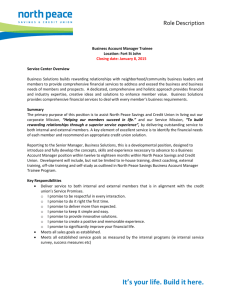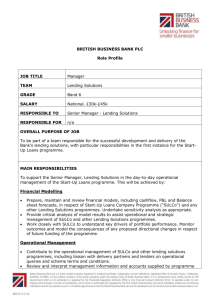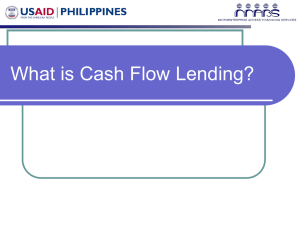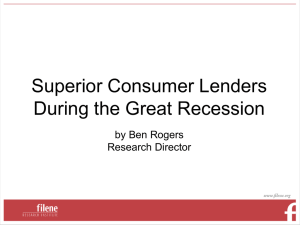Simplifying the Fair Lending Risk Assessment
advertisement
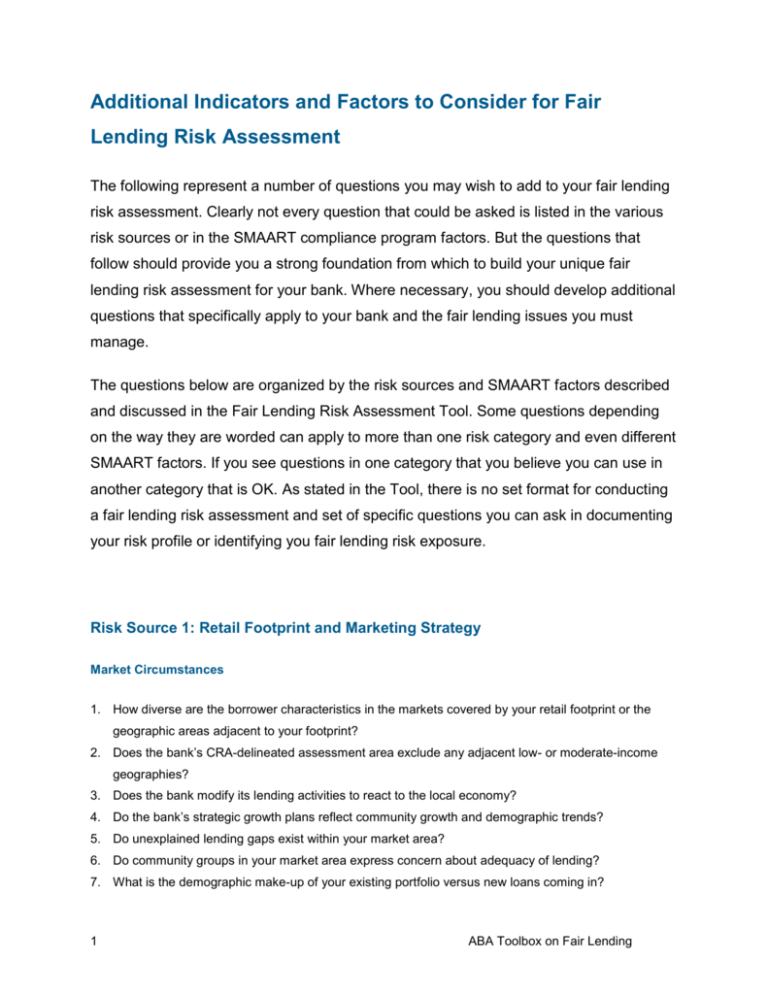
Additional Indicators and Factors to Consider for Fair Lending Risk Assessment The following represent a number of questions you may wish to add to your fair lending risk assessment. Clearly not every question that could be asked is listed in the various risk sources or in the SMAART compliance program factors. But the questions that follow should provide you a strong foundation from which to build your unique fair lending risk assessment for your bank. Where necessary, you should develop additional questions that specifically apply to your bank and the fair lending issues you must manage. The questions below are organized by the risk sources and SMAART factors described and discussed in the Fair Lending Risk Assessment Tool. Some questions depending on the way they are worded can apply to more than one risk category and even different SMAART factors. If you see questions in one category that you believe you can use in another category that is OK. As stated in the Tool, there is no set format for conducting a fair lending risk assessment and set of specific questions you can ask in documenting your risk profile or identifying you fair lending risk exposure. Risk Source 1: Retail Footprint and Marketing Strategy Market Circumstances 1. How diverse are the borrower characteristics in the markets covered by your retail footprint or the geographic areas adjacent to your footprint? 2. Does the bank’s CRA-delineated assessment area exclude any adjacent low- or moderate-income geographies? 3. Does the bank modify its lending activities to react to the local economy? 4. Do the bank’s strategic growth plans reflect community growth and demographic trends? 5. Do unexplained lending gaps exist within your market area? 6. Do community groups in your market area express concern about adequacy of lending? 7. What is the demographic make-up of your existing portfolio versus new loans coming in? 1 ABA Toolbox on Fair Lending 8. Do the demographics of the portfolio match the community demographics? 9. Are there conspicuous lending gaps within your service area?? Are there reasons that explain why? 10. Are there demographic shifts in the community that are not reflected in census data? 11. How does the local economy and competition impact your lending activities? 12. How consistent is the demographics of the loan portfolios with community demographics and identified credit needs? 13. How diverse are the borrower characteristics in the markets covered by your retail footprint or the geographic areas adjacent to your footprint? 14. Are market area determinations based on ZIP codes or census tracts rather than MSAs or larger geographical subdivisions when considering HELOC modifications? Delivery Channels 1. What delivery channels exist and do products or product terms vary by channel? 2. Does the bank have operating subsidiaries or loan production offices that originate loans using incentives or standards different from that of the bank? 3. Are underwriting and pricing standards consistent among lending channels and bank lending centers? 4. Are there any disparities on a prohibited basis by lending channels that originate the same product? 5. Does loan product marketing vary by geographic area or delivery channel? Is so, why and does it influence the products that are available to potential borrowers who may have differing prohibited basic characteristics? 6. Does any credit administration activity, such as application processing, servicing, loss mitigation, etc. vary by any delivery channel? 7. Does the bank have a wholesale lending operation which services a larger geographic area than the bank’s retail branch footprint? 8. Do underwriting terms for the same product vary depending on the delivery channel? Production Complexity 1. Does the bank only offer a traditional mix of non-complex loan products? 2. Are special prices, products, or services offered in some markets and not others? 3. Do different loan products penetrate geographic or borrower markets differently? 4. Is the bank using sophisticated lending platform technology to support loan production? 5. Are standards for referring applicants to other product choices, subsidiaries, or other lending channels clear, objective, and consistently applied? 6. Does the bank’s volume of and options for consumer, small business, and commercial lending match its business strategy throughout its market area? 2 ABA Toolbox on Fair Lending 7. Does the bank have a significant and explainable volume of consumer lending? Small Business lending? 8. Do credit administration changes impact only certain products or services? Marketing 1. Has the marketing and advertising media used varied recently? 2. Have new or different product sets been marketed and were they marketed throughout your market area? 3. Has marketing or advertising coverage within your market area changed recently? 4. Is marketing done in languages besides English? 5. Do marketing and advertising materials vary to promote special or limited time offers? 6. Is your level of marketing and advertising tailored or targeted to address market competition? 7. What types of media are utilized? 8. Is scripting for tellers or telephone sales representatives used? 9. Have the materials been reviewed prior to implementation? 10. What level of advertising is used to address market competition? 11. What loan product or service marketing is performed? 12. Would a reasonable person believe that your advertising patterns or practices indicate certain customers are less desirable? 13. Do you advertize only in media serving particular racial or national origin areas of the market? 14. Does marketing through brokers or other agents that the bank knows (or has reason to know) serve only one racial or national origin group in the market? 15. Do you use marketing programs or procedures for residential loan products that exclude one or more regions or geographies within the bank's assessment or marketing area that have significantly higher percentages of residents of a particular racial or national origin group than does the remainder of the assessment or marketing area? 3 ABA Toolbox on Fair Lending Risk Source 2: Degree of Credit Administration Discretion Allowed Lending policies and procedures approved by credit administration 1. Are credit operations centralized or decentralized? 2. Have credit administration guidelines, policies, and standards changed recently in any credit administration activity? 3. Are credit administration policies, procedures, and standards in each credit administration activity clear and objective, and communicated to appropriate staff? 4. Do procedures articulate expectations for providing consistent applicant/borrower assistance in each credit administration activity? 5. Are actual practices used in each credit administration activity consistent with established policy, procedure, or standard? 6. Are policies, procedures, and practices in each credit administration activity devoid of any overt discriminatory language, stereotypes, or geographic limitations? 7. If credit administration is decentralized, are products or services for separate operating centers evaluated separately. 8. If credit administration is decentralized, how effective is the enterprise-wide control environment? 9. Are loan applicants referred to other products that may be less advantageous or that are priced higher? 10. Are loan applicants referred to products in other lending channels? 11. Have credit administration policies, procedures, standards, or guidelines changed recently? 12. Are all credit administration personnel aware of changes to policies, procedures, standards, or guidelines? 13. Are credit administration policies, procedures, standards, or guidelines easy to incorporate into daily operations? 14. Are pricing and other terms and conditions standards objective? 15. Are underwriting criteria vague or subjective? 16. Are lending–related policies, procedures, and practices clear and objective? 17. Is loan underwriting centralized or decentralized? 18. Does credit administration employ automated underwriting standards? 19. Are scoring systems used in any aspect of the credit transaction (underwriting, pricing, servicing, waivers, credit line increases, and so forth)? 20. Do the automated scoring system cutoff scores appear objective and based in solid financial decisioning? 21. Are automated scoring systems used for all applications of the same type? 22. Are escrow account procedures clear and objective? 23. Is fair lending part of product development and approval processes? 4 ABA Toolbox on Fair Lending Degree of discretion in credit administration process 1. What amount of judgment or discretion can credit administration staff exercise in making decisions? 2. Does the degree of permitted discretion change by geographic area, delivery channel or credit activity – application processing, underwriting, loss mitigation, servicing, etc.? 3. Can the exercise of discretion impact lender or other staff compensation? 4. Do lenders or other staff involved in different credit activities – application processing, underwriting, servicing, etc. - document their exercise of discretion? 5. Are criteria that guide lenders and other staff discretion clear and objective, and how are the criteria communicated to appropriate staff? 6. Are there disparities in the level of permitted discretion exercised in each credit administration activity by prohibited basis characteristics? 7. Are pricing policies and guidance for discretion objective? 8. Are corrective actions taken when discretion errors or missteps are found? 9. Is lender discretion covered in bank policies and procedures 10. Does the practice of exercising discretion vary from formal policy and procedure? 11. How objective are the criteria that guide originator discretion and how are they communicated? 12. Do files contain sufficient information to document lending decisions? 13. Are loan underwriting standards explicit and do they provide objective guidance for any discretion given to the lending staff? 14. Are the controls in default management and loss mitigation tightly managed or is there a large amount of discretion allowed for servicers in collections, workouts, and/or foreclosures or repossessions? Lending results 1. Do unexplained approve/deny disparities on a prohibited basis exist by loan product or credit administration activity? 2. Do unexplained pricing and other terms and conditions disparities on a prohibited basis exist by loan product or credit administration activity? 3. Do unexplained disparities among application processing times (in any credit administration activity) exist by prohibited basis group? 4. Is there a difference in the proportion of approved not accepted and withdrawn/incomplete applications by a prohibited basis group? 5. Are there disparities in the percentage of prohibited basis group applicants in loan products or products with specific features relative to control group applicants? 5 ABA Toolbox on Fair Lending 6. Do you have disparities in the percentage of prohibited basis group applicants/borrowers in specific credit products, servicing activities, or loss mitigation solutions, for example, compared to the percentage of prohibited basis group applicants/borrowers offered different options or solutions? 7. Are there any disparities on a prohibited basis by lending channels that originate the same product? 8. For different loan products offered based on credit risk levels, are there any disparities by each loan product category on a prohibited basis? 9. If you acquired another institution or purchased loans are like products consolidated into one portfolio such that one loan in the portfolio may have been underwritten under one set of parameters where another loan may have different parameters? 10. Are there disparities in the incidence of rate spreads of higher-priced loans by prohibited basis characteristics as reported in your bank’s HMDA data? 11. Are there significant differences in the percentage of prohibited basis group applicants in loan products or products with specific features relative to control group applicants? 12. Are there significant differences, as revealed in HMDA data, in the number of applications received, withdrawn, approved not accepted, and closed for incompleteness or loans originated in those areas in the bank's market that have relatively high concentrations of residents of a particular racial or national origin group compared with areas with relatively low concentrations of residents of such racial or national origin group? 13. Do you have significant differences between approval/denial rates for all applicants in areas with relatively high concentrations of residents of a particular racial or national origin group compared with areas with relatively low concentrations of residents of such racial or national origin group? 14. Are there significant differences between denial rates based on insufficient collateral for applicants from areas with relatively high concentrations of residents of a particular racial or national origin group and those areas with relatively low concentrations of residents of such racial or national origin group. 15. Does your CRA data indicate patterns of lending that differ by the concentration of residents of a particular racial or national origin group? 6 ABA Toolbox on Fair Lending Risk Source 3: How Exceptions are Handled Exceptions 1. Is file documentation clear on why exceptions were granted? 2. Do exceptions require pre-approval? 3. Are loan credit and pricing/terms decision exceptions low in number and objective? 4. Does the incidence of exceptions vary by prohibited basis characteristic? 5. Are there particular lenders, offices, or management levels that have more or less exceptions considering the number for the overall bank? What does this mean? 6. Are exceptions permitted in other credit administration activities and is there clear documentation to support the exception? 7. Is the exception rate for pricing or fee waivers/charges minimal? 8. Are exceptions not on a prohibited basis? 9. Are corrective actions taken when exception errors or missteps are found? 10. What is the frequency of loan credit decision exceptions? 11. What is the frequency of loan pricing exceptions? 12. Are there particular lenders or offices that have more or less exceptions considering the number for the overall bank? What does this mean? 13. Are permissible loan exceptions described or well-established and is authority and instructions for documenting their exercise clear? 14. Do policies and procedures change when exceptions become the norm? 15. Has credit administration developed guidance for handling automated scoring system overrides and exceptions (commonly called “overlays”)? 16. Are there any manual processes associated with your automated scoring system? 17. Do lenders follow automated underwriting standards? 18. What are the parameters for exceptions in using your automated scoring systems? 19. Is there clear guidance on for making exceptions to underwriting criteria, including credit scoring overrides? 20. Do loan files contain clear documentation of reasons for any exceptions to standard underwriting criteria, including credit scoring overrides? 21. Are there relatively high percentages of either exceptions to underwriting criteria or overrides of credit score cutoffs? 7 ABA Toolbox on Fair Lending Risk Source 4: Role of Third Parties in Your Lending Operations Due Diligence 1. Does the bank use TPOs in the lending process that could impact fair lending compliance (brokers, servicers, appraisers, call Centers, application aggregators, etc.)? 2. Do you evaluate whether the TPO control structure manages the processes you have contracted to TPOs? 3. Does the bank have written agreements with each TPO addressing its fair lending obligations? 4. Do agreements with define responsibilities and accountabilities, and require regular reporting? 5. Are there explicit contractual warranties for fair lending compliance undertaken by any TPO involved in the bank’s lending activities? 6. Is due diligence performed prior to beginning the relationship and periodically thereafter? 7. Are TPO fair lending compliance programs required to be available for review by your bank? Execution 1. How frequent are there staff or customer complaints about TPO conduct? 2. Are weaknesses in TPO operations corrected promptly? 3. How extensively does the bank outsource credit administration activities? 4. Is there a formal re-approval and risk assessment process to consider TPO performance over the past period (year, quarter, etc.) to ensure that on an overall basis the relationship with the bank and its customers is satisfactory? 5. Are TPO fair lending compliance programs required to be available for review by your bank? 6. What information do you have about the quality of the training of TPOs regarding fair lending legal requirements? 7. Do TPOs have strong automated controls, testing, and monitoring? 8. Are TPO employees trained and knowledgeable regarding fair lending legal requirements? 9. Are compliance review and audit findings corrected promptly? Is retrospective relief considered when appropriate? 10. Does the TPO perform its own assessment, and is it reliable? 11. Are regulatory agency guidelines considered in managing TPO relationships? 12. Do you perform compliance reviews of the TPOs involved in your lending business? 13. Are your compliance review findings of TPO operations corrected promptly? 14. Are TPO fair lending complaints addressed and resolved, if possible? 8 ABA Toolbox on Fair Lending Risk Source 5: Technical Regulation B and HMDA Requirements Regulation B 1. Do lenders collect information, conduct inquiries, or impose conditions contrary to express requirements of Regulation B? 2. Are spousal signature requirements followed? If, so is there clear file documentation to validate the spouse’s involvement in the lending process? 3. Is government monitoring information collected in accordance with Regulation B? 4. Is appropriate loan documentation required to be kept consistent with record retention requirements? 5. Is marital status taken into consideration when processing applications, underwriting loans, or securing loan collateral? 6. How do loan policies or practices handle sources of income that are not the result of current full-time income? 7. Are loan application forms consistent with appropriate law and regulation requirements? 8. Do you collect Government Monitoring Information in accordance with Regulation B requirements? 9. Do your forms and instructions for gathering applicant and closing information fulfill reporting and record-keeping requirements? 10. Have there been any employee or bank statements that evidence attitudes based on a prohibited basis? 11. Is there a timetable or schedule for making required disclosures to applicants? 12. Do you have automated scoring systems that score age one of prohibited basis characteristics? HMDA and other loan data questions: 1. Does the bank have a history of HMDA data violations cited by your regulator? 2. Have HMDA data resubmissions been required in the past? 3. Is HMDA data review and submission outsourced? 4. Is the HMDA loan application register (LAR) updated quarterly? 5. Have you had to pay Civil Money Penalties (CMP) for inaccurate HMDA data? 6. Have members of the public requested your HMDA data? 9 ABA Toolbox on Fair Lending Risk Source 6: Fair Lending Environment Current Fair lending Environment 1. Has anything material changed recently in B, FHA, UDAP, HMDA, related state law? If so, did the bank have adequate time to implement, and do all affected personnel understand the new requirements? 2. What are competitors saying about the current fair lending environment? 3. What is your regulator emphasizing in recent publications? 4. Have credit products of the type your bank offers been the focus of news coverage? 5. Is there private party litigation activity concerning products or practices like yours? 6. What are complaints saying above your fair lending practices? 7. What legal actions have been taken against the bank? Against peers? 8. What enforcement actions have been placed against the bank? Against peers? 9. If against peers, do you have any of those activities in your bank? 10. Has the bank been subject to fair lending referrals? 11. Has the bank been investigated by HUD for allegations of not complying with the Fair Housing Act? 12. Any discrimination complaints filed against the bank by governmental agencies? 13. What are the latest changes to fair lending laws and regulations? 14. Have community groups contacted the bank with issues? 15. What are the current hot buttons with community groups in your market area? In general? 16. What are other lenders being criticized for? Do you have any of those activities in your bank? 17. Are community or other consumer groups consulted when developing loan products or programs to help serve community credit needs? 18. Have fair lending issues been raised in the past? 19. Do you have litigation alleging discrimination in loan servicing or loss mitigation practices? 10 ABA Toolbox on Fair Lending SMAART Factors Systems 1. Are credit administration standards explicit and do they provide objective guidance for any discretion given to lenders and other appropriate staff? 2. Are permissible exceptions described in policy or well-established, and are authority and instructions for documenting their exercise clear? 3. Is the expected retail footprint of any new product or new geographic market roll-out required to be considered for redlining or steering risk in our business planning phase? 4. Do procedures articulate bank expectations on providing consistent applicant assistance in all credit administration activities? 5. Does your product development committee consider how credit administration risks will be controlled to manage discretion? 6. Does the bank have well-defined standard for each loan processing activity? 7. Do you or do TPOs you work with use loan-related software to help with the credit administration activities? 8. Are adequate resources devoted to fair lending compliance? 9. Is Management responsive to risk management and fair lending issues? 10. Does management consider fair lending risk in product and service development strategy? 11. Does management have an appreciation for fair lending risk? 12. Is management a hindrance to corrective action? 13. Does the bank have processes for assimilating fair lending legislative and regulatory changes? 14. If risk-based pricing is used, is it based on objective criteria and applied consistently? 15. Is there a difference in services available or hours of operation at branch offices located in areas with concentrations of residents of a particular racial or national origin group when compared with branch offices located in areas with low concentrations of residents of such racial or national origin group? 16. Do policies on receipt and processing of applications, pricing, conditions, or appraisals and valuation or on any other aspect of providing residential credit vary between areas with relatively high concentrations of residents of a particular racial or national origin group and those areas with relatively low concentrations of residents of such racial or national origin group? 17. Is guidance on determining appropriate loss mitigation options, making policy exceptions, or granting fee waivers clear and objective? 18. Do you provide clear consumer disclosures on loss mitigation options, the costs of each option, and the risks involved available? 19. Are procedures for determining a borrower's ability to repay when selecting loss mitigation 11 ABA Toolbox on Fair Lending options clear? 20. Are decision criteria for property inspections, broker price offers, appraisals, or other valuations clear and objective? 21. Have you developed a significant value decline methodology for HELOC modifications that is clearly supported, objectively determined, and consistently applied? 22. Is your process for establishing that a borrower's financial condition has significantly deteriorated beyond ability to repay, for HELOC modifications, reasonable, objectively supportable, and clearly documented? 23. Are soft or deteriorating market determinations for HELOC modifications based on reasonable economic criteria, supportable standards, consistently applied, and clearly documented? 24. Do your soft or deteriorating market or declining market value determinations for HELOC modifications consider potential disparate impact/redlining implications? 12 ABA Toolbox on Fair Lending Monitoring 1. Are lender and other staff permitted to exercise judgment or discretion, and is it monitored? 2. Does the bank use a second review program? Is the program applied to check for consistent application of underwriting or pricing standards? Is it applied to check for whether exceptions are made available on a consistent basis across similarly situated borrowers? 3. Does the bank monitor credit administration policy exceptions and servicing activities and solutions in the regular course of operations against the bank’s standards for their usage? 4. Does the bank monitor lending product volume changes and servicing activity volume and solutions by prohibited basis and geographic distribution? 5. Are product disparity ratios in each credit administration activity reviewed by prohibited basis and geographic distribution? 6. Are customer concerns or questions about their experiences with your credit operations recorded and evaluated by management for fair lending red flags? 7. Are acceptance rates for loan solicitations or pre-screened offers monitored? 8. Are exceptions tracked as to frequency and magnitude? 9. How valid and reliable is your HMDA data? 10. Do you perform errors and omissions testing on your HMDA data? 11. Are HMDA key fields validated? 12. Are exceptions tracked and monitored? 13. Have automated scoring systems been tested and validated? Are system changes made with Compliance sign-off? Is there disparate impact testing before the system goes into production? 14. Are servicing activities handled in an adequate control environment, including policies and procedures, quality assurance, ongoing monitoring, training, automation, and management oversight? Billing, Call handling, Automated dialers, Payoffs and Lien releases, Payment processing? 15. Are loan assumptions handled in a controlled manner with adequate monitoring and oversight? 16. Does management monitor the timeliness and accuracy of established fair lending management information systems? 17. Does management annually review the effectiveness of the fair lending risk management program? 18. Are there fair lending risk factor reviews of issues by severity and frequency of occurrence? 19. Are fair lending compliance reviews performed? 20. Is loan decision making monitored for consistency with established policies, procedures, and practices? 21. Are product disparity ratios reviewed by prohibited basis and geographic distribution? 22. If lenders are permitted to exercise judgment or discretion how is it monitored? 23. Does the bank have quality control functions to assess fair lending compliance? 13 ABA Toolbox on Fair Lending 24. Does the bank perform fair lending regression analysis or statistical modeling to ensure fair lending compliance? 25. In response to prior identified fair lending issues, what did follow-up reviews indicate? 26. Have there been adverse findings related to processing time differences in the past? 27. Are fair lending complaints and outcomes tracked to ensure that bank staff is adhering to bank policies and procedures, following regulatory requirements, and treating customers consistent with bank customer service standards? 28. Are variables included in credit scoring systems that constitute a prohibited basis by Regulation B or, for residential loan scoring systems, the FH Act? 29. Have internal audits, compliance reviews, or monitoring reports identified significant weaknesses or violations in handling exceptions, fee waivers, incorrect credit reporting agency reporting, or complying with bank policies and procedures? 14 ABA Toolbox on Fair Lending Assessment 1. Does the bank have quality control functions to assess fair lending compliance? 2. Does the bank audit department assess fair lending compliance throughout the credit administration process? 3. Does the board review annually the fair lending risk management program effectiveness? 4. Are fair lending risks evaluated during due diligence efforts when acquiring other institutions? 5. Does the bank conduct assessments of the fair lending risk that flows from its lending operations? 6. Are customer complaints identifying fair lending claims handled in accordance with bank processes for investigation, response and appropriate remedy and any necessary systems improvements? 7. Have reviews been performed to ensure that consumers received what was advertised? 8. Do you use surrogate data for files where data is not available, such as serviced loans, credit cards, other consumer and business credit – use of surname for race and ethnicity and given name for sex; use of geocode indicator to determine if the applicant lives in a predominantly minority or non-minority tract? 9. Have automated systems been tested to ensure compliance with Regulation B? 10. Are fair lending self- assessment results shared with the appropriate senior management? 11. What is the scope and frequency of internal audit for fair lending risk factors? 12. Is statistical modeling and regression analysis performed on HMDA or non-HMDA data? If so, are results reported and recommendations followed? 13. Does the bank perform self-evaluations or self-tests? Are weaknesses or potential problems addressed appropriately and consistently with ECOA and FHA requirements? 14. Was due diligence performed before acquiring or purchasing a loan portfolio? Was level of fair lending risk assessed? 15. Are new product launch dates stopped if fair lending concerns are brought up? 16. Are unintended fair lending consequences identified and assessed when developing new lending products before product launch? 17. What have been the results of fair lending mystery shopping? 18. Are fair lending complaints aggregated and where appropriate compared to marginal approved and denied applicant files of similar products? 19. Are complaints assessed for information that may result in changes to products, services, marketing activities, policies, procedures, or customer service standards to reduce complaint numbers? 20. Are complaints assessed to surface regulatory concerns that could result in violations of law or regulations such as discouraging applicants, discriminatory practices, unfair and deceptive acts and practices, or abusive or predatory practices? 21. Does the bank have turnover in its lending functions? 15 ABA Toolbox on Fair Lending Accountability 1. Does the board foster a strong fair lending compliance culture within the bank and provide resources necessary to fulfill the bank fair lending objectives they set? 2. Is there appropriate communication or reporting across board, senior management, business lines, and compliance groups to enable each to perform their roles and be accountable for their performance? 3. Does senior management incorporate bank enterprise-wide fair lending risk and performance reports in their business decisions? 4. Does the compliance staff perform periodic fair lending self-assessments and other fair lending compliance reviews, and recommend changes to policies, procedures, and standards as appropriate? 5. Do business line staff and managers understand that “they own” their unit’s fair lending risk and are responsible for managing it? 6. Are there specific fair lending compliance requirements written into job descriptions of management and credit administration personnel, and is the compliance unit consulted to obtain feedback when performance reviews are done or before bonuses are paid? 7. Are business lines responsible for addressing fair lending risk and ensuring compliance with legal requirements? 8. Are fair lending implications of loan marketing strategies and materials included in new loan product review processes? 9. Is the expected retail footprint of any new product or new geographic market roll-out required to be considered for redlining or steering risk in your business planning phase? 10. Is there any compensation system based on loan production or loan pricing? If so, is there an incentive for a loan officer to charge more than the pricing sheet? 11. Is the loan officer compensated for certain types of credit, creating a potential fair lending risk of steering? 12. Is the loan officer compensated for higher dollar credit, creating potential Disparate Treatment or Disparate Impact issues? 13. What factors are used to compensate loan originators? 14. Can the exercise of discretion impact originator compensation? 15. Are fair lending responsibilities clearly defined? 16. Do fair lending technology solutions adopted by the bank incorporate bank standards? Are such solutions appropriate to the size and complexity of the lending operation? 17. Does the bank have well-defined standards for each loan processing activity? Such as loan approval, loss mitigation, marketing and advertising, and handling of delinquencies? 18. Are fair lending considerations incorporated into all bank areas such as roll out of new products, advertising, form changes and disclosures? 19. Does the Board incorporate fair lending requirements in its strategic planning process? 16 ABA Toolbox on Fair Lending 20. Does the board review fair lending performance? 21. Are the anticipated fair lending risks associated with Board business planning identified in Board background materials for consideration in business plan decision-making? 22. Is failure to meet the bank’s fair lending compliance expectations a component of compensation? 23. Are fair lending risks evaluated during due diligence efforts when acquiring other institutions? 24. Have statement s been made by the bank's officers, employees, or agents which constitute an express or implicit indication that one or more such persons have engaged or do engage in discrimination on a prohibited basis in any aspect of a credit transaction? 25. Have there been employee or bank statements that evidence attitudes based on prohibited basis prejudices or stereotypes? 17 ABA Toolbox on Fair Lending Response 1. Does management respond promptly to fair lending regulatory examination findings? Are root causes determined for any weaknesses or violations found and are appropriate program changes established? 2. Does the bank have a process in place to capture, review, and respond to consumer fair lending complaints? 3. Is management apprised when consumer complaint investigation evidences program weaknesses, customer assistance breakdowns, or potential violations? 4. Is bank staff able to raise issues or concerns about the fair lending impact of bank operations? 5. Does management consider and respond to fair lending and other credit-related issues or concerns raised by local community groups? 6. Does the bank have a process in place to quickly evaluate, recommend appropriate actions, and implement updated fair lending policies and procedures as new regulatory requirement are mandated or changes are made to current regulatory requirements? 7. Is management’s response to identified fair lending deficiencies prompt? 8. Is there a process for requests for compliance resources to be raised with senior management 9. Is feedback from consumer response programs shared with managers so they can correct staff mistakes? 10. Are fair lending concerns addressed during new product development and approval processes? 11. Are customer complaints alleging fair lending violations (as well as UDAP and abuse) dealt with separately, and with the proper degree of urgency? Allegations of misleading advertising, or predatory lending? 12. Does the bank have a process to capture and respond to consumer fair lending complaints? 13. Is prompt management action taken on complaints which evidence potential weaknesses or violations? 14. Does management monitor complaints for response back to the customer and provide appropriate resolution as possible? 15. Are consumer complaints raising fair lending concerns resolved promptly? 16. Are remedies implemented to resolve consumer complaint root causes? 18 ABA Toolbox on Fair Lending Training 1. Does bank staff involved in credit administration activities and technical support have fair lending knowledge and expertise appropriate to their responsibilities? 2. Does the bank fair lending training cover requirements of fair lending laws and regulations and how they apply to all credit administration activities? 3. Does the compliance officer or other compliance staff participate in compliance working groups with other local bank compliance officers or with state association compliance efforts? 4. Are the compliance officer and other bank compliance staff provided training opportunities to stay current with changing regulatory requirements and industry compliance challenges? 5. Does the bank offer fair lending training to or know that TPOs it uses provide training to their staffs? 6. Does the bank have processes for assimilating fair lending legislative and regulatory changes, as well as new fair lending hot topics being emphasized by regulatory agencies that affect its operations? 7. Does targeted training cover the right audiences? 8. Is training adequate in depth? 9. Does training cover customer service issues? 10. Is training frequent (at employee hire and ongoing or refresher throughout)? 11. Is training updated as needed? 12. If there is a test or passing score, is it adequate? 13. Does bank staff involved in lending activities and technical support have appropriate fair lending knowledge and expertise? 14. Does the bank’s fair lending training cover requirements of the fair lending laws and regulations? 15. Are lending policies, procedures and practices clearly communicated to staff with fair lending responsibilities? 16. Does new lending–related staff receive timely and up-to-date fair lending training? 17. Does the bank provide or ensure fair lending training it is received by third-party loan originators or providers the bank uses? 18. Is new staff given adequate training? 19. Does remaining staff have to take on additional responsibilities? Were these responsibilities new to them? 20. Does staff understand their responsibilities and accountabilities? 19 ABA Toolbox on Fair Lending
